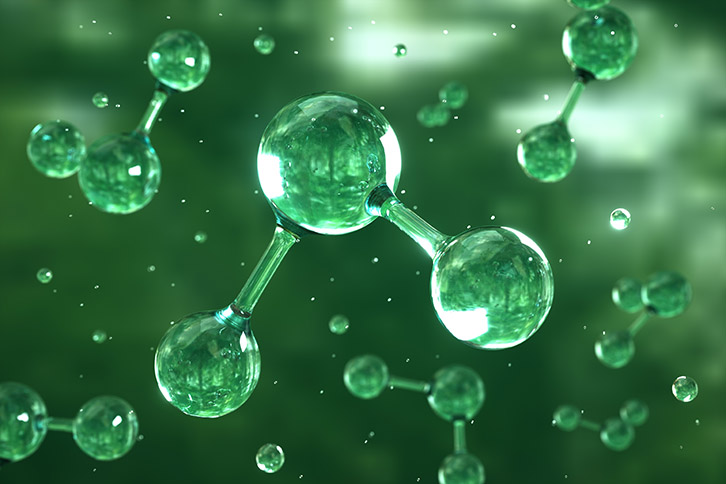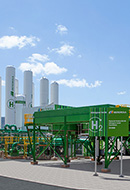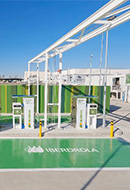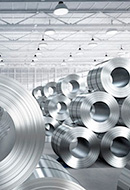Green ammonia
Green ammonia: the sustainable revolution in the chemical industry
Green hydrogen Decarbonisation
Green ammonia, also known as renewable ammonia, is a form of ammonia that is produced using renewable energy sources and which is proposed as a sustainable, emission-free alternative with a multitude of applications in industry and other sectors.

What is green ammonia and how is it produced?
Ammonia (NH3) is a nitrogen and hydrogen-based chemical compound widely used in the production of fertilisers and industrial chemicals. Ammonia is currently produced from natural gas and in its production process, emits 2 tonnes of CO₂ for every tonne of ammonia. For this reason, conventional ammonia is referred to as grey ammonia. The current market volume is around 185 million tonnes globally. Approximately 90 % of this is produced and consumed captively by industries that need ammonia as a raw material in their production processes. The remaining 10 % is traded internationally.
Green ammonia, on the other hand, does not emit CO₂ in its production process and is therefore expected to grow exponentially in production to replace grey ammonia and can be used for additional uses.
To produce green ammonia, green hydrogen must first be obtained through a process of water electrolysis. That is, water is decomposed into hydrogen and oxygen, using electrical energy generated from renewable sources. The hydrogen is then combined with atmospheric nitrogen through a process known as Haber-Bosch synthesis, which allows hydrogen and nitrogen to react at high pressure and temperature in the presence of a catalyst to form ammonia. The end result is the production of green ammonia using green hydrogen and atmospheric nitrogen.
What are the main uses of green ammonia?
This type of chemical compound is widely used in the production of agricultural fertilisers as ammonia is an essential source of nitrogen for plant growth. It is also used as a raw material in the production of a variety of chemical products, such as nitric acid, synthetic fibres, explosives, dyes and pharmaceuticals.
In addition to traditional uses, the emergence of green ammonia will give rise to new demand uses with high growth potential. On the one hand, ammonia is considered an energy vector as it enables efficient hydrogen transport and storage. It involves an additional process called "cracking" which consists of re-splitting the NH molecule3 to recover the hydrogen contained in it. Another possible new use for green ammonia is as a fuel for ships and it could play a relevant role in the decarbonisation of the maritime sector. Finally, green ammonia has the potential to be used as a fuel in boilers, turbines or engines to generate heat and electricity, reducing greenhouse gas emissions.
“Green” ammonia
Production and use cycle
- Renewable energy
- Electrolysis
- Ammonia synthesis (Haber-Bosch)
- Air separation
- Green ammonia
- Green hydrogen vector
- Chemical industry
- Fertilizers
- Ship fuel
- Electricity and heat generation

 SEE INFOGRAPHIC: "Green" ammonia. Production and use cycle [PDF]
SEE INFOGRAPHIC: "Green" ammonia. Production and use cycle [PDF]
What are the main benefits of green ammonia?
Among the main advantages of this chemical compound are the following:
- Emission reductions: Green ammonia, being produced using renewable energy sources, does not emit carbon dioxide (CO₂) during its production and therefore its use will be key to reducing emissions in the so-called "hard to abate" sectors that currently use conventional ammonia produced from carbon-intensive natural gas. Thus, by replacing it with green ammonia, dependence on fossil fuels is reduced and greenhouse gas emissions are reduced, thus contributing to climate change mitigation.
- Increased energy supply security: green ammonia reduces dependence on fossil fuels in general and Russian gas in particular in Europe. By using renewable energy sources, green ammonia is produced from local resources and reduces current exposure to fossil fuel price volatility (required in conventional ammonia production).
- Energy vector or hydrogen carrier: while hydrogen liquefies at a temperature of -253°C, ammonia only requires cooling to -33°C. Liquefaction is necessary to transport and store these compounds. The lower requirements for ammonia make this process much more competitive and energy efficient than H2 transport. Thus, once the necessary infrastructure for import, storage and cracking of ammonia is developed, it will be possible to produce green hydrogen in locations with optimal conditions (competitive renewable energy) and then export it to other consuming regions.
- Contribution to renewable energy deployment: Meeting future demand for green ammonia will require large amounts of new renewable electricity to meet the requirements set by the EU Delegated Acts for the definition of hydrogen and renewable derivatives. According to the RePowerEU plan, 20 million tonnes of renewable hydrogen will be needed in 2030 to decarbonise local industry. Of this, 10 million tonnes will be produced domestically and the rest will be imported in the form of ammonia.

Green and blue hydrogen
Discover the importance of hydrogen colours.

Green methanol and the maritime transport
This chemical compound is a promising alternative to fossil fuels.

What are hydrogen stations?
Hydrogen dispensers function as a refuelling station.

Green steel
The decarbonisation of steel allows for a reduction in emissions from this industry.




